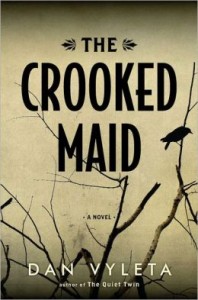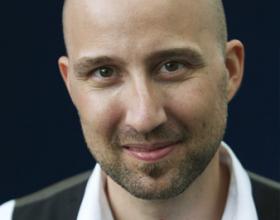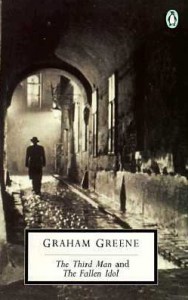“[Sophie Coburn’s] a lost soul. Came here because this is where her husband died …Vienna is finished, is what she says. Finito. For journalists [like her], she means. No more stories here. She even heard they are going to do a movie. In the fall. With Orson Welles. She was really quite upset.”—Karel Newmann to Anna Beer, 1948
 Setting his latest novel in Vienna in 1948, nine years after the setting for his previous novel, The Quiet Twin, author Dan Vyleta continues the story of the city and some of its characters in the aftermath of the Holocaust’s atrocities, though this novel stands alone and is not really a sequel. Here Vyleta uses characters some readers already know in order to show how they have changed in the nine years that have elapsed since The Quiet Twin, while, at the same time, introducing these characters in new contexts and illustrating their changed lives, which makes them fresh and intriguing to new readers of Vyleta’s work. The Quiet Twin, set in 1939, uses an apartment house in Vienna as a microcosm for the competing forces in Vienna before the war, providing insights into how ordinary people were seduced by Nazi rhetoric and promises, and how and why some of them so willingly compromised their own values when they were threatened during a time of crisis. The Crooked Maid, set in 1948, by contrast, shows how they have been changed by war’s horrors, by imprisonment (in some cases), by living as refugees in other countries, and by the cumulative trauma of a city which has been in the grips of unimaginable evil and now finds itself uncertain of its values and its future.
Setting his latest novel in Vienna in 1948, nine years after the setting for his previous novel, The Quiet Twin, author Dan Vyleta continues the story of the city and some of its characters in the aftermath of the Holocaust’s atrocities, though this novel stands alone and is not really a sequel. Here Vyleta uses characters some readers already know in order to show how they have changed in the nine years that have elapsed since The Quiet Twin, while, at the same time, introducing these characters in new contexts and illustrating their changed lives, which makes them fresh and intriguing to new readers of Vyleta’s work. The Quiet Twin, set in 1939, uses an apartment house in Vienna as a microcosm for the competing forces in Vienna before the war, providing insights into how ordinary people were seduced by Nazi rhetoric and promises, and how and why some of them so willingly compromised their own values when they were threatened during a time of crisis. The Crooked Maid, set in 1948, by contrast, shows how they have been changed by war’s horrors, by imprisonment (in some cases), by living as refugees in other countries, and by the cumulative trauma of a city which has been in the grips of unimaginable evil and now finds itself uncertain of its values and its future.
As the dramatic action begins to unfold, the novel may appear, at first, to be a simple murder mystery within an historical setting, similar, perhaps to those written by many popular, best-selling authors, but Dan Vyleta transcends genre, his writing more similar to that of Dostoevsky than to pop fiction. The many mysteries and even murders that take place during this mesmerizing and fully-developed novel grow out of the moral vacuum in Vienna after the war, the macabre details of these crimes so deeply rooted in the city’s psyche that they feel almost “normal” in the context of the times. Vienna’s citizens, fearing retribution from a variety of sources, now freely ignore their crimes and even deny their co-operation during the Nazi occupation, or as one character notes, “We are a people who have already forgiven themselves.”

Filmed in Vienna in 1948, The Third Man, starring Orson Welles, is set in the midst of reconstruction.
The novel opens with a woman of about forty, Anna Beer, returning by train to Vienna from Basel, after being away from Vienna for nine years. She has just learned that her husband, Dr. Anton Beer, has been released from a Soviet prison camp, and though she had been separated from him because of his infidelity, she wants to meet him again to resolve personal issues. She is sharing a compartment with a teenage schoolboy, Robert Seidel, who is also returning to Vienna after being away at boarding school, unable to see his family for over five years. As the two passengers chat, Robert indicates that there are family secrets, perhaps involving the maid, that his father is hospitalized after falling out a window, and that his brother has “disappeared.” Despite the serious subject matter, however, Robert’s story is told in a casual, almost bantering tone, at this point, suggesting that the author has something more complex on his mind than a straightforward mystery story, no matter how dramatic. The foreshadowing and foreboding develop further after the two passengers arrive in Vienna, where a mysterious man with a red scarf watches the two arrive, the connections among the three of them unknown.
As the novel takes off in different directions, Anna discovers that though her husband was released five or six days before her arrival, no one in Vienna has seen him for three days. Robert Seidel returns to his house, which reeks, filled with garbage and flies, and meets Eva Frey, the only maid. Eva, who is his own age, has a crooked back, almost a hunchback, and she is tending to Robert’s mother, who is addicted to a closetful of drugs. Eva also tends to a roomful of crows who keep her company in the loft where she spends much of her time, the crows being an ominous symbol that repeats throughout the novel. Robert’s half-brother Gustav was a Gestapo officer during the Nazi occupation, but he eventually has “rehabilitated” his reputation as did so many other residents of Vienna, and moved back home. By the time of Robert’s arrival, however, Gustav has been jailed on suspicion of having pushed his father from the window, for reasons unknown.
As the search for information about Anton Beer becomes more serious, and as Robert Seidel tries to figure out what is happening in his house, additional characters are introduced, though how much is true about each one involves many other mysteries. Most of the characters are not who they say they are, and their stories cannot be taken at face value. Robert, we learn early on, has been adopted by his stepfather. His birth father worked on behalf of the Gestapo (and was the villain of The Quiet Twin). We also learn early that Eva grew up in an orphanage and was hired to work for Robert’s family when she was fifteen. Soon overlaps begin to develop and characters find their fates intertwined. People disappear for periods of time, then reappear; conspiracy theories abound, even within families; new families are introduced to further the action, and bodies begin to appear; deliberate misdirections and ambiguities keep the tension high and the uncertainties fresh as those with something to gain manipulate outcomes. Throughout it all, a stranger with a red scarf keeps appearing and reappearing, though no one knows for sure who he is.
The novel’s unlikely coincidences, so obviously deliberate, and the author’s occasional flashes of humor remind the reader that the plot is one of the least important aspects of this novel for the author, though the plot is very good, very exciting, and very complex. His focus on the social aspects of the 1948 atmosphere, lead him to begin each major section of the novel with historical data from Stalingrad which shows the horrors of this war in terms of sheer numbers—one shocking statistic of which is that of 91,000 German, Austrian, Rumanian, and allied soldiers taken prisoner at Stalingrad, fewer than 6,000 returned home. Those who survived imprisonment were released slowly, between 1945 and 1955, and that number includes some of the characters here. Eventually, every detail is either explained or resolved, if it can be resolved, and the novel is brought full circle. Intense, beautifully structured, and challenging, this novel will thrill those interested in a “mystery novel” filled with dark ironies, a novel which goes far beyond the limitations of that genre.
ALSO by Dan Vyleta: THE QUIET TWIN
Photos, in order: The author’s photo appears on http://www.weeklystandard.com/
The poster of the Third Man, starring Orson Welles, is from http://providencedailydose.com/
The rubble of Vienna, by Keystone/Hutton Archive/Getty Images may be found on
http://www.dw.de/
The damage to architectural treasures, by Picture-Alliance DPA, appears on http://www.dw.de
Graham Greene’s The Third Man, which was the basis of the film, is available as a Penguin Classic. http://www.amazon.com/Third-Fallen-Classic-20th-Century-Penguin/dp/014018533X




